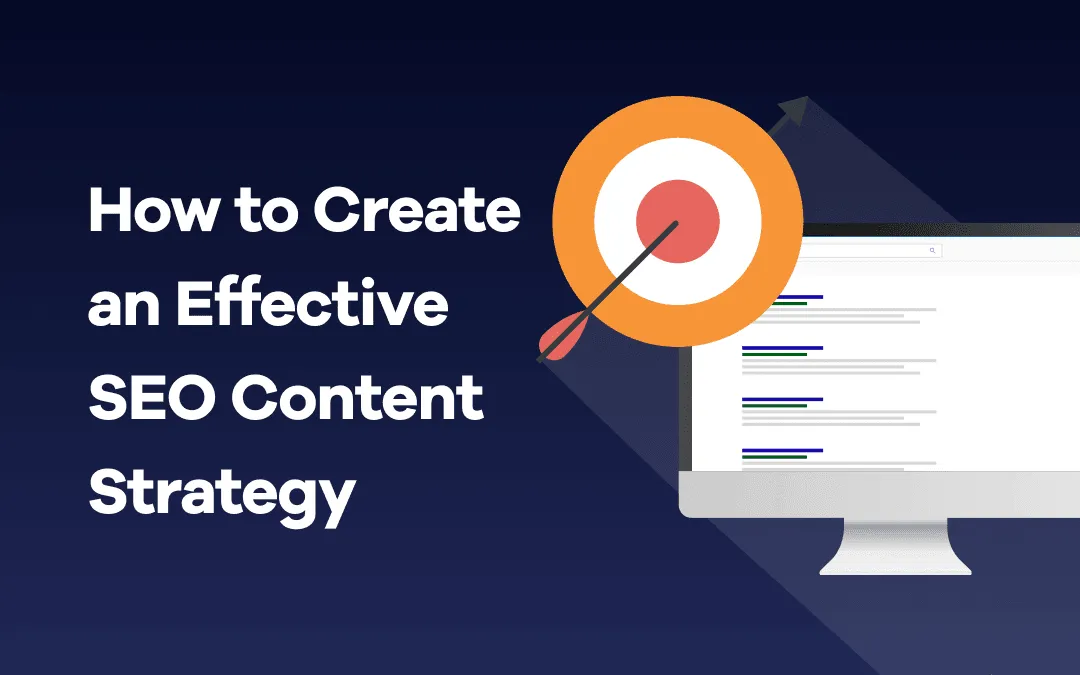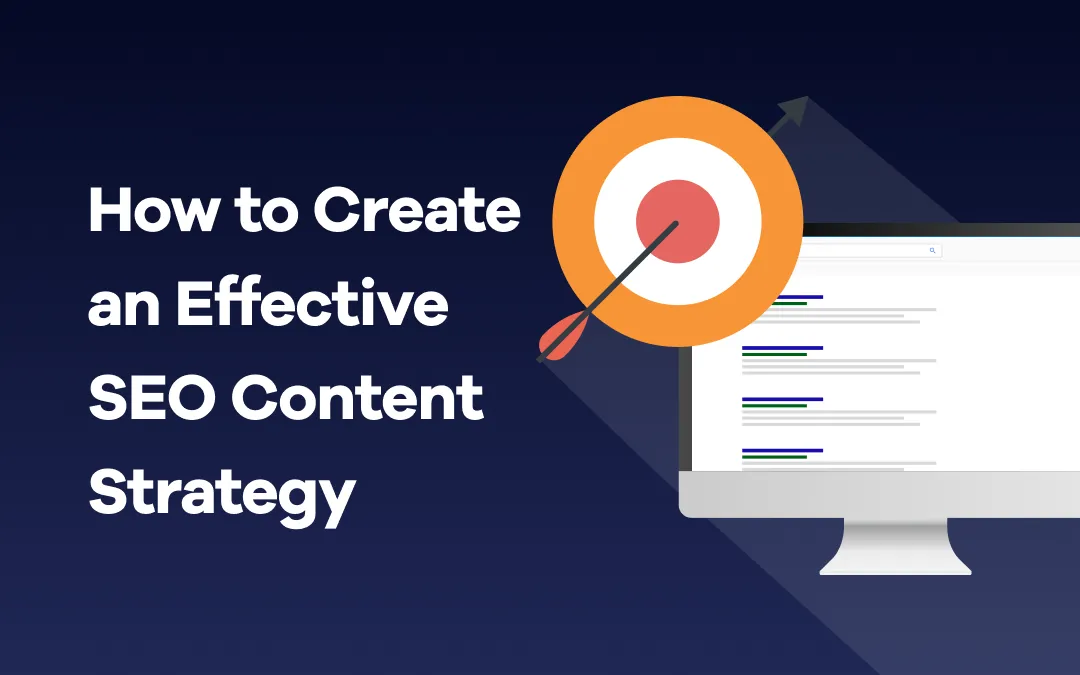
How to Create an Effective SEO Content Strategy

Bo Ekkelund
November 16, 2022
With an SEO content strategy, you can create relevant content that ranks on search engine pages while driving results to your business.

For every post you publish in a month, you are up against 70 million other posts, and that is only WordPress alone.
Without a strategic approach, driving traffic, attracting leads, and generating revenue with content is impossible.
One way to increase your chances of content success is to use an SEO content strategy. With an SEO content strategy, you can create relevant content that ranks on search engine pages while driving results to your business.
In this article, you will be learning how to integrate SEO into your content strategy. But before then, how does SEO and content strategy work together?
How Can SEO and Content Strategy Work Together?
SEO and content strategy play a significant role in marketing. But there are misconceptions about how they work (individually and together). A good example is that people think SEO is a content strategy which is not the case.
SEO is a channel for distributing content like social media and email. Optimizing your content for search engines is a powerful means of distributing content in front of the right people.
About 93 percent of online experiences begin with a search engine. This makes SEO an effective way of driving web traffic and getting the right eyeballs to your site.
However, SEO is only effective if you have a solid content foundation. Search engines like Google rank websites that publish high-quality content consistently.
Google is consistently releasing updates that ensure websites create high-quality and valuable content. A notable example is Google's helpful content update which rewards content that meets your web visitors' expectations.
Briefly, having a content strategy helps you produce content that catches your audience's attention. But by optimizing your content for search engines, you stand the chance of driving quality traffic and leads to your website.
Benefits of Using an SEO Content Strategy
Here are some reasons why you should invest in an SEO content strategy:
It drives organic traffic to your site
Creating search-friendly content can drive organic traffic to your website through search results.
According to Internet Live Stats, Google alone processes more than 3.5 billion daily searches and 1.2 trillion searches per year worldwide. This explains why more companies prioritize SEO because it is an effective way to drive traffic.
An excellent example is Kinsta, a fast-growing WordPress hosting company that leverages SEO to increase its web traffic by 571 percent in just 13 months.

It helps improve your ROI
Content marketing requires time, money, and effort from your marketing team. Churning out content without a plan might lead to failure.
An SEO content strategy helps you spell out your marketing goals and how you plan to execute them. This way, you can allocate the resources at your disposal better. You will also know what forms of content you are investing in (visual, audio, or written content) beforehand and assign tasks to your content team.
It helps demonstrate your value
Content like case studies or testimonials effectively shows how your product or service can improve your prospects' lives.
A good example is how Float, a resource management software, outlined how their client Social Chain, a global social media agency, uses their tool to manage the workflows and resources in their growing international team.
Establish authority and trust
Creating content that solves your target audience's problems builds trust with them and reinforces a positive impression of your brand. It is also an excellent way to build authority in your industry and position your brand as an industry expert.
Driving Results with an SEO Content Strategy Step-by-Step
This step-by-step guide outlines how to approach creating an SEO content strategy that will drive traffic and leads to your website and convert prospects to customers:
Step 1: Define your business goals
Your SEO content strategy should support your marketing and business goals.
For instance, if your marketing goal is to gain two hundred new customers monthly, your SEO content strategy should be heavily focused on driving conversions and nudging leads down the sales funnel.
Step 2: Identify your target audience
Understanding who your audience is and what makes them tick helps understand their pain points and how to position your products or services to solve them.
An excellent way to start your audience research is by speaking to your existing customers about their pain points. And if you cannot talk to customers, speak with your customer success or sales team. Ask them the top complaints they hear from customers or sales objections that always pop up in conversations with prospects.
Another great way to understand your customers is by using data from the demographics and interests feature in your Google Analytics to find out information like age, gender, and interests of your customers.
Social media channels like Instagram, Twitter, and Facebook also offer information about who your customers are, where they are from, and their interests.

Step 3: Conduct keyword research and analysis
Keyword research helps you identify relevant topics and use keywords to drive traffic to your website through search.
Start keyword research by brainstorming for seed keywords; foundational terms that provide related topics you want to target. First, brainstorm a list of ten topics relevant to your business. For example, your seed keyword for a time-tracking software company can be "time management" or "time logging".
Once you have a list of seed topics, plug them into a keyword research tool to find more keyword opportunities to target. You can also uncover new keywords by finding out some of the top keywords your competitors are ranking for.
Another way to pick the right keywords is to identify the search terms using a tool like AccuRanker’s Keyword Discovery you are already ranking for. Going back to our example above, you might discover that your blog also ranks for a term like “time tracking”. Targeting a keyword like this could place you in front of the right audience.
Step 4: Build topic clusters
Building topic clusters also lets you improve your topical authority which can impact your SEO performance positively. It is also an effective strategy to keep readers on your site for longer as they click through to related pages.
Topic clusters have three main components, namely:
- Pillar content - a core topic
- Topic clusters - narrow subtopics relevant to the pillar content
- Interlinks - internal web links that help readers (and search engine robots) navigate through these subtopics.
To build a topic cluster, start by finding a core topic for your pillar page. Consider a topic that one piece of content will not cover in-depth. For example, "time management".
Then break it down into several subtopics. For example, time management can have subtopics like:
- What is time management?
- Time management skills
- How to manage time better
- Time management skills
- Time management software
- Time management strategies
- How to improve time management
- Time management techniques
You can store these in a spreadsheet and interlink them as you write each piece.
Ensure you choose a keyword relevant to your product with high search volume and medium keyword difficulty (this is dependent on your domain ranking) as your core topic.

Step 5: Create a content calendar
A content calendar (or editorial calendar) is a detailed schedule that outlines your content plan over a certain period. It can help you stay coordinated and organized throughout your marketing process by providing a central location for team members to collaborate.
To create your content calendar:
- Choose a tool: This could be a calendar like Google Calendar or a project planner like Notion or a dedicated content calendar like [Coschedule](https://coschedule.com/.
- List your content ideas: You can categorize your planned content assets by type. For example, blog posts, white papers, landing pages, etc.
- Choose a frequency: How often will you publish? Weekly, biweekly, or monthly? Pick a publishing frequency that matches your team size and capability.
- Schedule sub-tasks: Map out every task needed to successfully create your content. For example, a blog post would have various stages like creating briefs, drafting, editing, image creation, and publishing. Assign a due date to each of these tasks.
Assign tasks: Allocate each team member to the work they need to do. You can tag them within the tools or send them messages in Slack.
Building Quality Backlinks Will Help with Your SEO Content Strategy
Backlinks are a vote of confidence from other websites and signal to search engines that your site has valuable information.
There are different ways you can approach link building but here, we will be outlining three methods:
Creating linkable assets like case studies, infographics, and reports. A good example is Buffer's State of Remote Work 2021 Report.
Having a link building outreach which is more complex. A link building outreach involves sending emails and messages to sites in your niche to link to your content assets on their website.
Guest posting on high-authority blogs in your industry in which you link to specific pages on your website.
Update And Refresh Existing Content
After some time, your existing content can become outdated. This might affect its performance on search engine results pages.
By regularly refreshing your content, you avoid content decay and provide relevant information to readers. To find pages that need refreshing, search for content assets that have dropped in ranking using your SEO tool.
When you identify these pages, do the following to refresh them:
- Update outdated information
- Remove irrelevant sections
- Fulfill the right search intent
- Add new sections/paragraphs (if necessary)
Update page titles and metadata
SEO Content Strategy with AccuRanker
AccuRanker can help you to create an SEO content strategy. A product that provides you with on-demand data on how you are performing on SERPs, will also help you understand which SERP feature is driving traffic to your website. A step in the right direction for SEO content strategy.
Start increasing your organic traffic today with AccuRanker.
Related blog posts
The Hidden Flaws in Search Volumes and How to Solve Them
Learn how AI Search Volume delivers reliable search volumes by combining GKP, GSC, and Trends so that you can prioritize the right keywords.
1 July 2025
AI Overviews Are Taking Over SERPs
From traffic drops to decreasing CTRs, AI Overviews are shaking up SEO. Learn what is happening and how AccuRanker helps you track AIO.
25 June 2025
How AccuRanker’s AI Models Fix Inaccurate SEO Data
Struggling with unreliable SEO data? Discover how AccuRanker’s CTR, Search Intent, Search Volume, and Share of Voice deliver accurate insights.
1 June 2025




